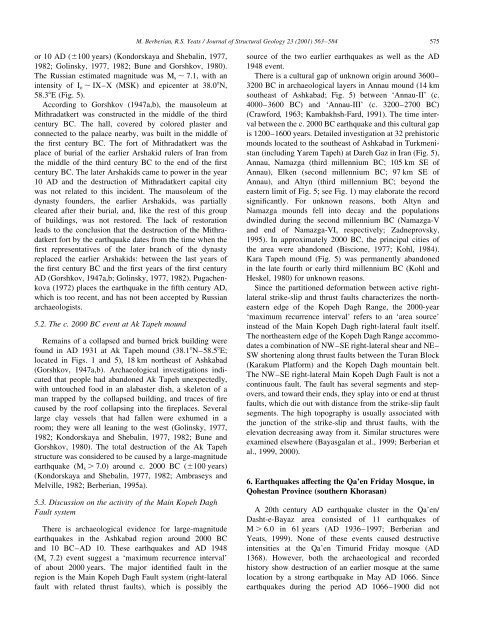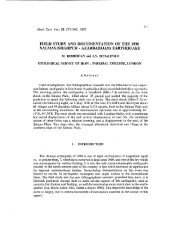574M. Berberian, R.S. Yeats / Journal of Structural Geology 23 (2001) 563±584intensity of X (MSK) in the area south of Annau±KuruGaudan±Gyaurs with N308E tension fractures at KuruGaudan (Medvedev, 1955; Gorshkov, 1957; Rezanov,1959; Rustanovich, 1967); (ii) buckling to a height of 1 mof the water pipes in several places in Kuru Gaudan village,with telescoping of one pipeline over a length of 3 m(Butovskaya and Kovalenko, 1955); (iii) ¯inging of theroofs from cattle sheds to a distance of several meters inan NE±SW direction (Butovskaya and Kovalenko, 1955);and (iv) a 22-cm subsidence of the Trans-Caspian Railwaybased on re-leveling at Gyaurs (Butovskaya and Kovalenko,1955; Kolibaev, 1962).The Kuru Gaudan surface ruptures striking N308E weredeveloped approximately perpendicular to the KuruGaudan±Zarineh Kuh anticlinal axis (striking NW±SE) onthe hanging wall of the Gyaurs thrust (Fig. 5). This suggeststhat the ®ssures were sur®cial extension fractures and faultsdeveloped on the hanging wall of the Gyaurs blind thrust asthe Kuru Gaudan±Zarineh Kuh anticline was folded duringthe 1948 earthquake. The Kuru Gaudan±Zarineh Kuhanticline is an asymmetric fold with a steeper dip alongthe northeastern faulted ¯ank (the Gyaurs surface fault inTurkmenistan), a shallower dip along the southwestern ¯ank(in Iran), and plunging ESE in Iranian territory. Pleistoceneloess deposits covering the southeastern section of theanticline axis in Iran are now at an elevation of 1997 m,about 317 m higher than loess deposits in the area east ofDareh Gaz (Fig. 5), where the nose of the anticline plungesunder the loess deposits of the plain (1688 m). Theassociation of the Kuru Gaudan±Zarineh Kuh fold withthe Gyaurs blind thrust suggests that it is a fault-propagationfold. The relative subsidence of the plain north of the KopehDagh mountain is recorded by alluviation and burial of thelower cultural levels of major prehistoric mounds such asNamazga and Kara Tapeh (Fig. 5) beneath several metersof alluvial deposits. Virgin soil was reached at 11.5 mbeneath the present surface of the plain in the southernTrench No. 2 at Namazga (Namazga-I ,5000 BC, whichgives a deposition and/or subsidence rate of 1.6 mm/year),3 m below Namazga-IV (3000±2500 BC; 0.6 mm/year),and 8.5 m below Namazga-III (3500±3000 BC; 1.5 mm/year) deposits (Kuftin, 1956; Kohl and Heskel, 1980; F.T.Hiebert, personal communication, 2 May 2000). The mapshowing the total vertical crustal displacement during theNeogene and Quaternary (Czovsky et al., 1960) clearlyrecords the subsidence of the Kopeh Dagh foredeep (theAshkabad plain) and uplifting of the Kopeh Dagh mountainbelt.A poorly constrained fault-plane solution for the AD1948 earthquake (McKenzie, 1972) shows a thrust mechanismwith an almost shallow plane dipping SSW. Thismechanism agrees with that of Rustanovich and Shirokova(1964), who combined this solution with the results of levelinglines to show that the shallow plane dipping SSW wasthe fault plane (Fig. 5). Rezanov (1959) and Rustanovich(1967) proposed a shallow SSW dipping fault at the contactof Mesozoic and Paleozoic deposits in the Kopeh Daghforedeep, 10 km below the Ashkabad±Bezmein plain.Despite the low accuracy of the locations, the two aftershockstudies based on temporary networks in 1949 and1953 indicated that the majority of the shocks were locatedat 10±20 km depth, concentrated near the NW and SE endsof the zone of maximum destruction in Turkmenistan, atKuru Gaudan (in the SE) and Bezmein (in the NW) (Rustanovich,1957; Koridalin et al., 1961; Puchkov, 1961; noaftershock record is available from the Iranian side). Thisand the re-triangulation results of 178- to 190-cm rightlateraldisplacement at Ashkabad (Butovskaya and Kovalenko,1955; Kolibaev, 1962) suggest that the AD 1948earthquake, with reverse sur®cial deformation at KuruGaudan, was also associated with right-lateral strike slipalong the Main Kopeh Dagh Fault system at depth. TheMain Kopeh Dagh Fault consists of several partly overlappingsegments parallel to the overall NW±SE structurewith stepovers. The regions of overlap are characterized byshorter south-dipping thrust faults striking about E±W (Fig.5). Trifonov (1978) reported active displacement alongthe Main Kopeh Dagh Fault for more than 500 km, withright-lateral displacement of 30 cm and 10 m of the wallsand the nearby qanats (traditional underground watercanals) of the Parthian palace of Mithradatkert (Nesa). Heestimated right-lateral Holocene displacement of 8 m, andHolocene±Late Pleistocene displacement of 55±60 m alongthe Main Kopeh Dagh Fault.5.1. The c. 10 BC±AD 10 event at the capital city ofMithradatkert (Nesa mound)The present Nesa mound, the ancient Mithradatkert,located 17 km west of Ashkabad and 8 km south of Bezmein(Fig. 5) is the site of the capital city of the Parthyene Districtof the Parthian Empire (second century BC to third centuryAD) of ancient Persia. A palace, a cathedral, and twomausoleums were excavated in the destroyed fort ofMithradatkert. The upper part of a pyramid-stepped towerin the mausoleum at Mithradatkert was found torn fromthe wall so that the tower had collapsed. Two of thethree columns supporting the roof of the hall had fallen;the top part of the third one and the remaining part ofthe shaft had been tilted to one side. The inner part of theeast wall, with half-columns standing alongside it, wasfound tilted toward the middle of the hall. The interiorwas ®lled with roof beams and fallen debris from theupper part of the mausoleum (Gorshkov, 1947a,b). Thisdestruction near the beginning of the Christian era, whichtotally destroyed the capital city of Mithradatkert, isattributed to a strong earthquake. Judging from the positionof the fallen and displaced column shafts, the direction oftilt of the towers, and the inner parts of the east wall, thebasic direction of ground shaking was estimated to beapproximately east to west (Golinsky, 1977). The earthquakeoccurred in 10 BC (Ambraseys and Melville, 1982)
M. Berberian, R.S. Yeats / Journal of Structural Geology 23 (2001) 563±584 575or 10 AD (^100 years) (Kondorskaya and Shebalin, 1977,1982; Golinsky, 1977, 1982; Bune and Gorshkov, 1980).The Russian estimated magnitude was M s , 7.1, with anintensity of I o , IX±X (MSK) and epicenter at 38.08N,58.38E (Fig. 5).According to Gorshkov (1947a,b), the mausoleum atMithradatkert was constructed in the middle of the thirdcentury BC. The hall, covered by colored plaster andconnected to the palace nearby, was built in the middle ofthe ®rst century BC. The fort of Mithradatkert was theplace of burial of the earlier Arshakid rulers of Iran fromthe middle of the third century BC to the end of the ®rstcentury BC. The later Arshakids came to power in the year10 AD and the destruction of Mithradatkert capital citywas not related to this incident. The mausoleum of thedynasty founders, the earlier Arshakids, was partiallycleared after their burial, and, like the rest of this groupof buildings, was not restored. The lack of restorationleads to the conclusion that the destruction of the Mithradatkertfort by the earthquake dates from the time when the®rst representatives of the later branch of the dynastyreplaced the earlier Arshakids: between the last years ofthe ®rst century BC and the ®rst years of the ®rst centuryAD (Gorshkov, 1947a,b; Golinsky, 1977, 1982). Pugachenkova(1972) places the earthquake in the ®fth century AD,which is too recent, and has not been accepted by Russianarchaeologists.5.2. The c. 2000 BC event at Ak Tapeh moundRemains of a collapsed and burned brick building werefound in AD 1931 at Ak Tapeh mound (38.18N±58.58E;located in Figs. 1 and 5), 18 km northeast of Ashkabad(Gorshkov, 1947a,b). Archaeological investigations indicatedthat people had abandoned Ak Tapeh unexpectedly,with untouched food in an alabaster dish, a skeleton of aman trapped by the collapsed building, and traces of ®recaused by the roof collapsing into the ®replaces. Severallarge clay vessels that had fallen were exhumed in aroom; they were all leaning to the west (Golinsky, 1977,1982; Kondorskaya and Shebalin, 1977, 1982; Bune andGorshkov, 1980). The total destruction of the Ak Tapehstructure was considered to be caused by a large-magnitudeearthquake (M s . 7.0) around c. 2000 BC (^100 years)(Kondorskaya and Shebalin, 1977, 1982; Ambraseys andMelville, 1982; Berberian, 1995a).5.3. Discussion on the activity of the Main Kopeh DaghFault systemThere is archaeological evidence for large-magnitudeearthquakes in the Ashkabad region around 2000 BCand 10 BC±AD 10. These earthquakes and AD 1948(M s 7.2) event suggest a `maximum recurrence interval'of about 2000 years. The major identi®ed fault in theregion is the Main Kopeh Dagh Fault system (right-lateralfault with related thrust faults), which is possibly thesource of the two earlier earthquakes as well as the AD1948 event.There is a cultural gap of unknown origin around 3600±3200 BC in archaeological layers in Annau mound (14 kmsoutheast of Ashkabad; Fig. 5) between `Annau-II' (c.4000±3600 BC) and `Annau-III' (c. 3200±2700 BC)(Crawford, 1963; Kambakhsh-Fard, 1991). The time intervalbetween the c. 2000 BC earthquake and this cultural gapis 1200±1600 years. Detailed investigation at 32 prehistoricmounds located to the southeast of Ashkabad in Turkmenistan(including Yarem Tapeh) at Dareh Gaz in Iran (Fig. 5),Annau, Namazga (third millennium BC; 105 km SE ofAnnau), Elken (second millennium BC; 97 km SE ofAnnau), and Altyn (third millennium BC; beyond theeastern limit of Fig. 5; see Fig. 1) may elaborate the recordsigni®cantly. For unknown reasons, both Altyn andNamazga mounds fell into decay and the populationsdwindled during the second millennium BC (Namazga-Vand end of Namazga-VI, respectively; Zadneprovsky,1995). In approximately 2000 BC, the principal cities ofthe area were abandoned (Biscione, 1977; Kohl, 1984).Kara Tapeh mound (Fig. 5) was permanently abandonedin the late fourth or early third millennium BC (Kohl andHeskel, 1980) for unknown reasons.Since the partitioned deformation between active rightlateralstrike-slip and thrust faults characterizes the northeasternedge of the Kopeh Dagh Range, the 2000-year`maximum recurrence interval' refers to an `area source'instead of the Main Kopeh Dagh right-lateral fault itself.The northeastern edge of the Kopeh Dagh Range accommodatesa combination of NW±SE right-lateral shear and NE±SW shortening along thrust faults between the Turan Block(Karakum Platform) and the Kopeh Dagh mountain belt.The NW±SE right-lateral Main Kopeh Dagh Fault is not acontinuous fault. The fault has several segments and stepovers,and toward their ends, they splay into or end at thrustfaults, which die out with distance from the strike-slip faultsegments. The high topography is usually associated withthe junction of the strike-slip and thrust faults, with theelevation decreasing away from it. Similar structures wereexamined elsewhere (Bayasgalan et al., 1999; Berberian etal., 1999, 2000).6. Earthquakes affecting the Qa'en Friday Mosque, inQohestan Province (southern Khorasan)A 20th century AD earthquake cluster in the Qa'en/Dasht-e-Bayaz area consisted of 11 earthquakes ofM . 6.0 in 61 years (AD 1936±1997; Berberian andYeats, 1999). None of these events caused destructiveintensities at the Qa'en Timurid Friday mosque (AD1368). However, both the archaeological and recordedhistory show destruction of an earlier mosque at the samelocation by a strong earthquake in May AD 1066. Sinceearthquakes during the period AD 1066±1900 did not







